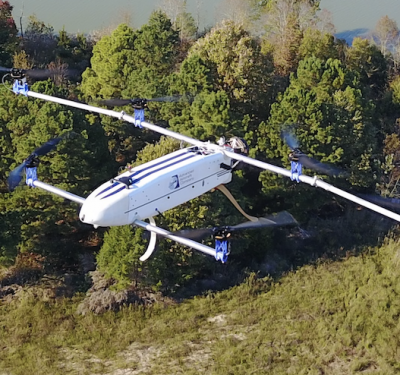
Wikimedia Commons photo by Lionel Allorge.
A research team from the Alliance for System Safety of UAS through Research Excellence (ASSURE) this week released a report that concludes that drones that collide with large manned aircraft can cause more structural damage than birds of the same weight for a given impact speed.
The Federal Aviation Administration (FAA) will use the research results to help develop operational and collision risk mitigation requirements for drones. ASSURE conducted its research with two different types of drones on two types of aircraft through computer modeling and physical validation testing.
Unlike the soft mass and tissue of birds, most drones are made of more rigid materials. The testing showed that the stiffest components of the drone – such as the motor, battery and payload – can cause the most damage. Concentrating those masses on the drone can also cause greater damage, the researchers found.
The research team evaluated the potential impacts of a 2.7-pound quadcopter and 4-pound quadcopter; and a 4-pound and 8-pound fixed wing drone on a single-aisle commercial transport jet and a business jet. They examined impacts to the wing leading edge, the windshield, and the vertical and horizontal stabilizers. The windshields generally sustained the least damage and the horizontal stabilizers suffered the most serious damage.
The structural damage severity levels ranged from no damage to failure of the primary structure and penetration of the drone into the airframe. However, the research specifically did not explore the risk to flight imposed by that damage. The researchers concluded that unmanned aircraft system manufacturers should adopt “detect and avoid” or “geo-fencing” capabilities to reduce the probability of collisions with other aircraft.
The team conducted a preliminary computer simulation to evaluate the potential damage to engine components if a drone is ingested into an aircraft engine, including damage to fan blades, the nacelle and the nosecone. They plan future additional research on engine ingestion in collaboration with engine manufacturers, as well as additional airborne collision studies with helicopters and general aviation aircraft.
In 2014 Congress directed the FAA to establish a UAS Center of Excellence. The FAA selected ASSURE, led by Mississippi State University, in May 2015
More on the ASSURE Report
Last month, a report from Canada indicated the possible collision of a drone with a jet approaching Quebec City’s International Airport. The incident reintroduced public concerns about air collisions between small unmanned aircraft systems (sUAS) and commercial aircraft and what it may mean to the safety of air travel.
Although the FAA is not yet able to definitively address these concerns, studies by a consortium of leading universities, through ASSURE, have begun to bring better understanding to the physical damage associated with small unmanned aircraft – or drones – colliding midair with commercial and business aircraft.
The ASSURE research team began its research in FY 2016, using unique resources from Mississippi State University, Montana State University, Ohio State University, and Wichita State University. This research team set out to answer the question of what happens when – not if – there is a collision between a sUAS and an airplane.
“While the effects of bird impacts on airplanes are well documented, little is known about the effects of more rigid and higher mass sUAS on aircraft structures and propulsion systems,” said Mississippi State University’s Marty Rogers, the Director of ASSURE. “The results of this work are critical to the safety of commercial air travel here in the United States and around the world.”
Researchers’ efforts began by first determining the most likely impact scenarios. This was done by reviewing operating environments for both sUAS and manned aircraft. The team then selected the commercial and business aircraft and sUAS based on these impact scenarios and their likely exposure to one another.
“Computer simulations, supported by material and component level testing, were conducted to determine the effects of sUAS impacts on manned aircraft,” said Gerardo Olivares, Ph.D., Director, Crash Dynamics and Computational Mechanics Laboratories at Wichita State University. “Conducting this study through full-scale physical tests would not have been possible from a cost and time perspective due to the immense complexity of the task. On the other hand, simulation enabled us to study over 180 impact scenarios in a twelve-month period. To ensure results accurately predict the actual physical behavior of collisions, we have spent a lot of time developing, verifying, and validating detailed models of manned and unmanned aircraft. Once the models are validated, we can use them in the future to investigate other impact scenarios.”
This is the first in a series of research projects conducted to understand and quantify the potential severity of airborne collisions. Future studies will research the severity of collisions with general aviation (GA) aircraft, rotorcraft, and high-bypass turbofan engines representative of those found in airline fleets today. Because of the scope and magnitude of this research, and the impact it will have on industry and national airspace safety, the follow-on studies will be broken into multiple phases beginning this year and running through FY21.






